Cicerchie and Black Kale Soup
What beans! What character! The humble cicerchie, Lathyrus sativus, with their hearty flavor have been a character on the world food scene for thousands of years. Paleobotanists have determined that cicerchie came to ancient Rome from Greece, having first made their way from the Near East along the northern coast of the Mediterranean. The ancient Romans called the legume cicercula, and the march of the Roman legions was fueled on soup made from them. Because cicerchie grow well in high altitudes and cool climates they have traditionally played a large part in the cuisine and farming of the central and southern Apennines, especially Abruzzo where they sustained the poor through good times and bad. Cicerchie farming and consumption decreased after WW II, but a resurgence is underway, thanks to the burgeoning interest in traditional foods and sustainable agriculture both in Italy and worldwide.
However, cicerchie have one characteristic that sets them apart and is worth addressing. They contain the neurotoxic amino acid ODAP (beta-oxalyl-diaminopropionic acid) associated with neurolathyrism, a neurodegenerative disease leading to paralysis of the lower limbs and muscle wasting. As soon as I mentioned this to Bart, his spoon stopped midway to his mouth. I realized research was in order, as was better timing.
Cicerchie, I learned, can grow in a variety of soils, including poor ones. They exhibit greater resistance to pests than other legumes. Additionally they are often the only crop to grow in harsh conditions brought on by drought or in lands devastated by war, and this is where the trouble comes in. Sadly, under these circumstances the legume becomes a staple, in fact, often the sole source of sustenance for the stricken people, and for many who consume it neurolathyrism sets in. Cicerchie are Mother Nature’s double edged sword.
Above is an aquatint etching from The Disasters of War, Goya’s series on the ravages of Spain’s war against the French, 1808- 1814. Here the artist depicts a woman unable to rise due to paralysis resulting from neurolathyrism. She is being aided by those around her, emaciated individuals whose gaunt faces mirror the effects of the Madrid Famine of 1811-1812.
I contacted Prof. Dr. Fernand Lambein of the Institute for Plant Biotechnology at the University of Ghent in Belgium. He is the coordinator of the of the Cassava Cyanide Diseases and Neurolathyrism Network and editor and publisher of their newsletter. I am very grateful to him for his generosity in answering my questions about neurolathyrism in general and cicerchie in particular. He offered his opinion in real terms of safe levels of consumption. Please note he uses grass pea, another name for cicerchie.
I estimate that about 50 kg of grass pea seed, consumed in continuation over a minimum time, say two months, can give a 6% chance of inducing neurolathyrism. In short, casual consumption of grass pea as one component of an otherwise balanced diet, bears not any risk of toxicity.
…Dr. Fernand Lambein
Thanks to Professor Lambein, Bart can breathe easily, and his spoon can finish its long interrupted journey to his mouth. See Food Nerd Notes below to read more of Professor Lambein’s comments.
Dried cicerchie look like small off-white dehydrated kernels of corn. They must be soaked for a full twenty-four hours prior to cooking, during which time they will swell and take on a yellowish cast. As with other dried legumes, I do not add salt to the cooking water until they have softened to avoid toughening the skin.
Cicerchie can be hard to find, although some specialty markets do carry them. I have tried several brands, but I have been particularly pleased with those from La Valletta Farm, a family owned company devoted to sustainable agricultural practices and the traditional grains and legumes of Italy. Their products arrive clean, free of stones and debris and whole, not in pieces as is the case with some brands. Their line of grains and legumes are available from Gustiamo.
Cicerchie and Black Kale Soup
serves 6
This hearty soup, packed full of vegetables and protein rich cicerchie, gets a flavor boost from the addition of basil pesto. I prefer to slice the onions very thinly rather than mince them. The soup is much more attractive sporting slices rather than tiny pieces of onion floating about the surface.
For the soup
12 ounces dried cicerchie
1 yellow onion, halved top to bottom and sliced very thinly
2 ribs celery, cut in ¼ inch dice
3 carrots, cut in ¼ inch dice
1 ½ bunches black kale, cut crosswise in ½ inch ribbons, inner stem removed and discarded
¾ cup green peas, fresh or frozen
4 cups brodo di pollo ( chicken broth)
1-2 teaspoons peperoncino flakes (red pepper flakes)
Salt and pepper
3 tablespoons olive oil
Rinse and pick over the cicerchie, discarding any discolored beans. Place in them in a large bowl and cover with 3 inches of cool water. Soak for 24 hours, changing the water two or three times as it clouds.
Discard any pieces of the tough indigestible outer skin that come away.
Drain and rinse the cicerchie. Transfer them to a 4-quart pot, and cover with 3 inches of cold water. Bring to a boil over high heat. Reduce to lively simmer, and continue cooking until the beans begin to soften, about 40 minutes, skimming off and discarding foam.
Meanwhile, pour olive oil into a separate heavy bottom 6-quart Dutch oven. Add the sliced onions and ½ teaspoon peperoncino flakes. Cover and cook over low to medium low heat about for 20 minutes, or until the onions have begun to caramelize, stirring occasionally to prevent scorching.
Remove the cover, add the celery and carrots, cook 15 minutes more. Add the stock. Drain the cicerchie and add them to the pan. Bring to a boil over high heat. Reduce to a simmer and continue cooking about 30 minutes more, or until the beans are done to your liking. Add chopped kale, peas, ½ teaspoon peperoncino flakes (or more if desired) and 1 teaspoon salt.
Cook about 15 minutes more, until kale has softened. Add a generous dose of freshly ground black pepper, and check for seasoning, adding more salt, pepper and peperoncino if desired. Ladle into bowls, top with a tablespoon of pesto, and serve.
 For the pesto
For the pesto
1 cup basil leaves, packed
1 clove garlic
¼ cup olive oil
2 tablespoons grated Parmigiano-Reggiano
Combine, basil, oil, and garlic in workbowl of food processor fitted with metal knife. Process the ingredients until finely ground and thoroughly combined. Scrape the pesto into a small bowl, add cheese and combine well. If you are not using the pesto right away, cover it with a thin film of olive oil to prevent oxidation. Store it in the refrigerator up to one week.
Food Nerd Notes:
Cicerchie are in the botanical Family of Fabaceae as are ceci and fava beans. They are known as alverjon or almorta in Spain where the beans are ground into flour to make gachas de almorta, an ancient porridge-like dish. Cicerchie are grown for human consumption and animal feed in Asia, the Middle East, northern Africa and southern Europe. Some other names include chickling pea, vetch, green vetch and khesari.
In the quest to feed a hungry planet the scientific community has cast its collective eye upon cicerchie. The levels of ODAP vary widely between the different varieties of cicerchie, and crossbreeding programs are underway to develop low ODAP varieties. The legume’s appealing taste and high nutritional value coupled with the plant’s hardy nature make it an attractive candidate for agriculture worldwide.
Here is more from Professor Lambein on the issue of neurolathyrism:
Toxicologists have studied the symptoms of neurolathyrism and tried to determine the threshold of toxicity. Because of the individual variability in tolerance to grass pea, a toxic dose has never been established with scientific methods. The reason may be that the toxicity is not only caused by beta-oxalyl-diaminopropionic acid (ODAP and BOAA are synonyms, but ODAP is chemically correct), but also by the imbalance of essential amino acids in grass pea like in all legumes. The amino acids essential in our defence against oxidative stress (involved in all neurodegenerations) are deficient in grass pea seed. The content of methionine in grass pea is only half of the content in soybean (the most healthy legume). If the diet contains at least one third of cereals (wheat, rice, maiz, sorghum etc.) there is a better balance of these essential amino acids and the risk for neurolathyrism is greatly reduced. Addition of anti-oxidant-rich foods such as onion, ginger are also protecting factors in the etiology of neurolathyrism. I estimate that about 50 kg of grass pea seed, consumed in continuation over a minimum time, say two months, can give a 6% chance of inducing neurolathyrism. In short, casual consumption of grass pea as one component of an otherwise balanced diet, bears not any risk of toxicity. In fact, popularising grass pea as a tasty legume can increase the price paid to the producers, who are among the poorest of the poor in the economically most backward countries such as Ethiopia and Bangladesh.
Dr. Lambein added
…the last cases of reported neurolathyrism in Europe were during the Second World War in the maquis of Greece and in a German labour camp in Vapniarca. Also during the Spanish Civil War there have been well documented cases of neurolathyrism. Apparently these were periods and areas of acute hunger, malnutrition and stress. Stress has recently been identified as an important factor in the aetiology of neurolathyrism in rats.
Note: You can click on any picture for a slide show!
I have no affiliation with any product, manufacturer, or site mentioned in this article.

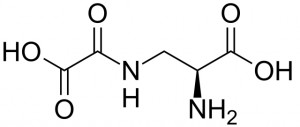


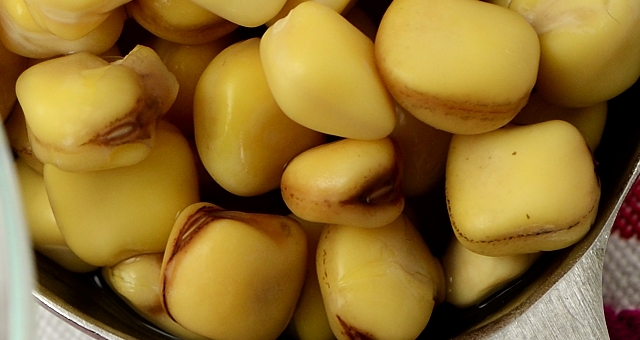
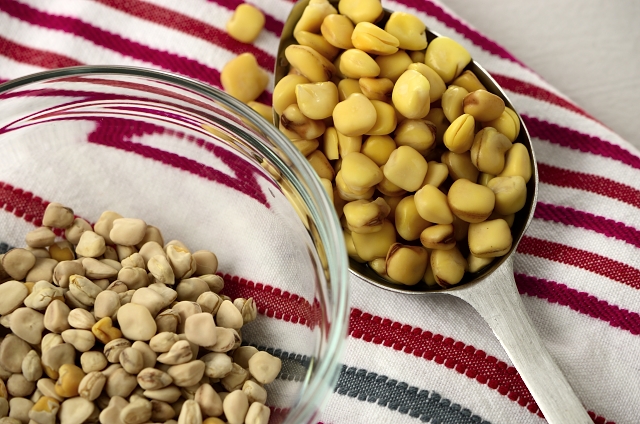


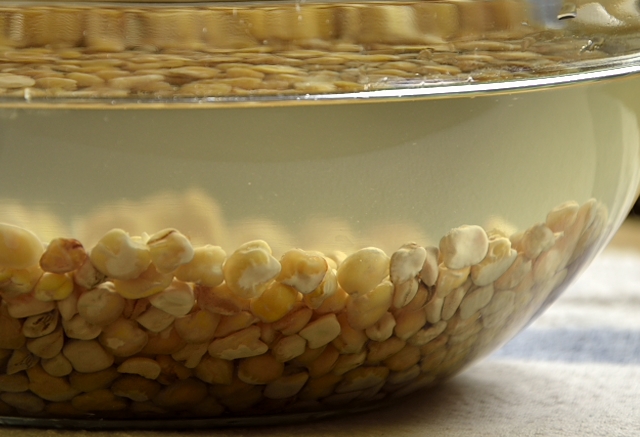
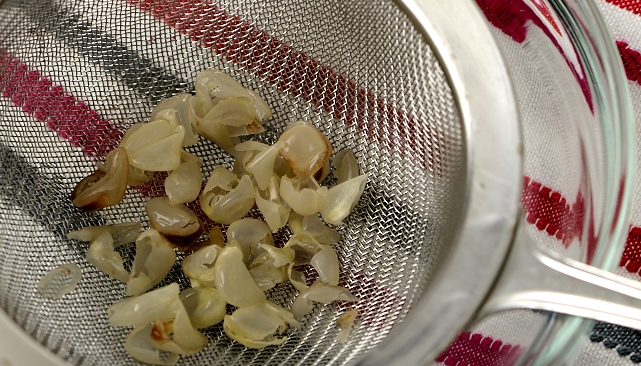




Tuesday, April 9th 2013 at 7:52 pm |
Brava Adri, You have written this post as well as any reporter given an assignment. I have never eaten cicerchie, to my knowledge, and I learned a lot about them from your well researched post. You even contacted a professor in Belgium? That’s what I call thorough my friend. As always, Bart’s photos are stellar and I love the angle he chose through the glass bowl of soaking beans.
Tuesday, April 9th 2013 at 8:35 pm |
Thanks, Linda,
Yes, I have SOURCES! I was quite curious after I learned about the neurotoxicity, so much so that I felt it would have been irresponsible to talk about these beans without a more thorough knowledge of the situation. Thanks for your support. I LOVE cicerchie. The taste is a bit woodsy, deeper than ceci. I bet you will like them. Bart says thanks!
Wednesday, April 10th 2013 at 12:15 am |
Adri, you certainly put together such a well researched and wonderful post, I am really impressed. I love this post and all the information, recipes, pictures and photos that it contains. I have learned so much from you today and I must admit that I had never heard of Cicerchie before either but since I will be going to my very favorite Italian market today, guess what I will be looking for – I will most certainly report back to you because I would love to know how they taste like, you make them sound and look so delicious. Mille grazie!
Wednesday, April 10th 2013 at 6:52 am |
Hi Andrea,
It is my pleasure entirely. I am so glad to hear you found this of interest. They really are one of nature’s strange gifts. They make me think of something one might read about in an old myth. I hope you enjoy them, and I would love to hear what you think.
Thursday, April 11th 2013 at 1:25 am |
Thanks for this delightful recipe, Adri. I’m always on the lookout for more cicerchie recipes.
Thursday, April 11th 2013 at 10:11 am |
Hi Mette,
I hope you enjoy it!
Thursday, April 11th 2013 at 6:27 pm |
I like cicerchie too! I also like to support a product grown in my native region. They take a bit more care to prepare, but then you are rewarded with something different and delicious. Lovely soup: I like how the deep green of the kale sparkles in the photos.
Friday, April 12th 2013 at 1:18 pm |
Hi Simona,
I agree. It is nice to support one’s local farmers. Although I am not from the area, the farms of the Colfiorito plain produce some wonderful agricultural products. I am happy to support Alessandro and Rosalba Cappelletti, the brother and sister team who now operate La Valletta Farm. I hope you try the soup, and thank you very much for visiting my site.
Saturday, April 13th 2013 at 5:04 am |
Un piattino favoloso e salutare, e poi che colori!!!!
Saturday, April 13th 2013 at 7:41 am |
Ciao Simona,
Davvero favoloso! Adoro le cicerchie!
Saturday, April 13th 2013 at 6:23 am |
Buone le cicierchie!! noi le facciamo solo con qualche pomodorino da mangiare con la pasta, ottima questa ricetta!
Saturday, April 13th 2013 at 7:43 am |
Ciao Vicky,
Non ho mai mangiato le cicerchie coi pomodorini e la pasta – devo provare la tua ricetta. Grazie.
Sunday, April 14th 2013 at 11:42 am |
I often skim through the narrative of a post to get right to the recipe. This post had me hooked, as I read the fascinating history and science behind this legume. We also like the addition of kale in the soup – it’s a green we’ve been using more in our own cooking.
Sunday, April 14th 2013 at 1:02 pm |
Hello,
I am glad you found it of interest; I was concerned that people would read through. I have come to view cicerchie as a real paradox. I am using kale more and more too. It has such great color and truly satisfying body. Thanks for stopping by! Alla prossima!
Monday, April 15th 2013 at 10:08 am |
This looks fabulous. I look forward to trying it!
Monday, April 15th 2013 at 11:24 am |
Benvenuta!
Thanks for visiting, and I hope you enjoy the cicerchie. They are wonderful.
Thursday, April 18th 2013 at 1:45 pm |
What an interesting post – I had no idea the background and history behind cicerchie. And the soup looks SO wonderful – I could go for a bowl right now!
Thursday, April 18th 2013 at 5:23 pm |
Hi Amy,
I am glad you enjoyed this- these little legumes have quite a history.
Thursday, April 18th 2013 at 2:15 pm |
What a fascinating bean, Adri! I would never suspect a bean could be a neurotoxin if eaten in large quantities or as a diet staple.
My husband’s family came from a mountain town in Calabria and he often said “hunger was the best sauce” when they were growing up, and that they mainly ate whatever could be harvested locally. I wonder if they ever had this bean? I will have to ask him this evening. I know they often had ceci and fava beans prepare in a soup such as this, but kale was unknown to them. They would probably use a heavy Italian flat string bean in their soups as a green, or zucchini.
Your husband’s photos are outstanding as always!
Thursday, April 18th 2013 at 6:16 pm |
Hi Pat,
Isn’t this an astounding story? Nature’s paradox in living color. I would love to hear your husband’s answer.
Friday, May 17th 2013 at 5:30 pm |
G’day, I’ve been trying to locate a local store in Australia which stocks this bean but have been unsuccessful as where I could get it no longer stocks them (Melbourne, Victoria) and I am in Perth, Western Australia, the other side of the country.
My dad loves this bean and I remember as a child eating it. I wanted to surprise him with a bag of it, so he can make some of his great soups that I remembered and for me to re-live my childhood 🙂
Does anyone know what online store I can buy them from where they will ship to Australia? I have tried some well known USA online stores, however they don’t ship to OZ.
Hope to read suggestions.
Regards.
Saturday, May 18th 2013 at 7:56 am |
Hi Frank,
Thanks for visiting and for writing. I checked with Gustiamo, the company in New York where I purchase my cicerchie, and they do not ship to Autralia. I am sorry I have no help to offer. I will leave this message up, and perhaps someone will see it! Best of luck finding them. I bet your father would be thrilled. Alla prossima!
Thursday, June 26th 2014 at 11:49 am |
Adri, thank you for posting this recipe! I had used half my bag of cicerchie (from Gustiamo) in a salad and was looking for a knockout recipe for the remainder. I had everything I needed to make this one, and it is a winner! Additionally, thank you for your thorough research and the information you provide. all the best, Michele
Monday, July 7th 2014 at 1:27 pm |
Hi Michele,
I am so pleased to hear you enjoyed this one. The more I researched these beans, the more intrigued I became, and it was a joy to communicate with Professor Lambein. He was so gracious and quite generous with his time.
I enjoy beans of all sorts, and use them frequently in soups, salads and stews. The woodsy character and toothsome texture of cicerchie make them real a real standout. They are one of my family’s favorites now. Thanks for stopping by and for your kind words! Alla prossima, Adri